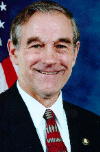The Pentagon recently reported that it now spends roughly $8.4 billion per month waging the war in Iraq, while the additional cost of our engagement in Afghanistan brings the monthly total to a staggering $10 billion. Since 2001, Congress has spent more than $500 billion on specific appropriations for Iraq. This sum is not reflected in official budget and deficit figures. Congress has funded the war by passing a series of so-called “supplemental” spending bills, which are passed outside of the normal appropriations process and thus deemed off-budget.
This is fundamentally dishonest: if we’re going to have a war, let’s face the costs – both human and economic – squarely. Congress has no business hiding the costs of war through accounting tricks.
As the war in Iraq surges forward, and the administration ponders military action against Iran, it’s important to ask ourselves an overlooked question: Can we really afford it? If every American taxpayer had to submit an extra five or ten thousand dollars to the IRS this April to pay for the war, I’m quite certain it would end very quickly. The problem is that government finances war by borrowing and printing money, rather than presenting a bill directly in the form of higher taxes. When the costs are obscured, the question of whether any war is worth it becomes distorted.
Congress and the Federal Reserve Bank have a cozy, unspoken arrangement that makes war easier to finance. Congress has an insatiable appetite for new spending, but raising taxes is politically unpopular. The Federal Reserve, however, is happy to accommodate deficit spending by creating new money through the Treasury Department. In exchange, Congress leaves the Fed alone to operate free of pesky oversight and free of political scrutiny. Monetary policy is utterly ignored in Washington, even though the Federal Reserve system is a creation of Congress.
The result of this arrangement is inflation. And inflation finances war.
Economist Lawrence Parks has explained how the creation of the Federal Reserve Bank in 1913 made possible our involvement in World War I. Without the ability to create new money, the federal government never could have afforded the enormous mobilization of men and material. Prior to that, American wars were financed through taxes and borrowing, both of which have limits. But government printing presses, at least in theory, have no limits. That’s why the money supply has nearly tripled just since 1990.
For perspective, consider our ongoing military commitment in Korea. In Korea alone, U.S. taxpayers have spent $1 trillion in today’s dollars over 55 years. What do we have to show for it? North Korea is a belligerent adversary armed with nuclear weapons, while South Korea is at best ambivalent about our role as their protector. The stalemate stretches on with no end in sight, as the grandchildren and great-grandchildren of the men who fought in Korea give little thought to what was gained or lost. The Korean conflict should serve as a cautionary tale against the open-ended military occupation of any region.
The $500 billion we’ve officially spent in Iraq is an enormous sum, but the real total is much higher, hidden within the Defense Department and foreign aid budgets. As we build permanent military bases and a $1 billion embassy in Iraq, we need to keep asking whether it’s really worth it. Congress should at least fund the war in an honest way so the American people can judge for themselves.




 Ron Paul is a former Republican congressman from Texas. He was the 1988 Libertarian Party candidate for president.
Ron Paul is a former Republican congressman from Texas. He was the 1988 Libertarian Party candidate for president. 